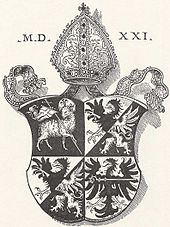Sebastian Sprenz
Sebastian Sprenz (also Sperantius or Sprenger, * around 1475 in Dinkelsbühl ; † October 3, 1525 in Bruneck ) was court advisor and diplomat to Emperors Maximilian I and Karl V, Prince-Bishop of Brixen , Chancellor of Tyrol, German humanist and poet with an interest in astronomy.
Life
Sebastian Sprenz comes from a dynasty of cloth dyeing seals, who settled in the imperial city of Dinkelsbühl between 1437 and 1456 and had a speckled bird (thrush, sparrowhawk) in their coat of arms. There is archival evidence of the family in Dinkelsbühl from 1456 to 1543. He was born in Dinkelsbühl around 1475 as the son of Jacob Sprenz and his wife Katherina. 1491 clergy with minor orders in Augsburg, 1493 matriculated at the University of Ingolstadt. 1499 head of the Latin school at St. Lorenz in Nuremberg, 1503 professor for poetics and rhetoric at the University of Ingolstadt. In 1506 he entered the service of the Prince-Bishop of Gurk. From 1510 he worked in the imperial court chancellery. In 1512 he was elected Provost in Brixen. In 1516, the doctor of both rights was ordained a priest in Augsburg. In 1517 he accompanied a Polish embassy to Italy on behalf of Emperor Maximilian I to ask for the hand of Princess Bona Sforza for the King of Poland. In the same year, the emperor campaigns for Sprenz's relatives from Dinkelsbühl. In 1520/21 he was the delegate of Emperor Charles V in the peace negotiations on the Thorner Compromise. In 1521 he was ordained bishop in Brixen. In 1523, the Prince of Tyrol, Archduke Ferdinand, appointed him Chancellor. In 1524 Emperor Charles V enfeoffed him with princely regalia at the Reichstag in Nuremberg. Because of the peasant uprising in 1525, Prince-Bishop and Chancellor Sprenz fled from his Innsbruck office to his castle in Bruneck, where he succumbed to an illness and found his grave.
German humanist
Sprenz worked as a poet and translator. As a member of the "Sodalitas litteraria Rhenana" founded by Celtis, he was in contact with a learned humanistic circle of friends. a. Conrad Celtis, Willibald Pirckheimer, Konrad Peutinger, Cuspinian, Wimpheling, Vadian, Pius Baldung, Johannes Reuchlin, Johannes Foeniseca and Veit Bild. He was given writings a. a. from Rudolf Agricola d. Dedicated to younger ones, Willibald Pirckheimer, Jakob Spiegel, Johannes Eck and by mathematician Christoph Rudolff.
astronomer
Sprenz put a sundial on St. Lorenz in Nuremberg in 1502. After 1503 he published the lost text "Fundamentum horologiorum ...", a basic work on sundials with a representation of the shadow lines. On the occasion of his appointment as Prince-Bishop in 1521, he received a specially made celestial and terrestrial globe as a gift in 1522, both of which are now in the Museum of Yale University in New Haven.
Plaque
Inscription on the south side of St. Georg Minster in Dinkelsbühl from 2017: Prince-Bishop · Imperial Diplomat / Sebastian Sprenz / 1480–1525 / Humanist · Astronomer · Hebrew · Poet · Peacemaker / R. Springholz
literature
- Rudolph Springholz: Timeline of Sebastian Sprenz (1480–1525) Prince-Bishop of Brixen from Dinkelsbühl; in: Historischer Verein Alt-Dinkelsbühl e. V., yearbook 2004–2006.
Individual evidence
- ↑ Contributions to the history of the episcopal church Säben and Brixen in Tyrol, Volume 2, p. 325 (1822) online
- ↑ Gerfrid Arnold: The Sprenz dynasty in Dinkelsbühl 1456 to 1543 - relatives of the emperor's advisor Sebastian Sprenz in archives of Dinkelsbühl provenance; in: Alt-Dinkelsbühl, Messages from History, 2018.
- ↑ Gerfrid Arnold: The relatives of the Dinkelsbühl citizen son and imperial councilor Sebastian Sprenz in Dinkelsbühler sources between 1456 and 1543. In: Alt-Dinkelsbühl, Mitteilungen aus der Geschichte, 2018.
- ^ Gerfrid Arnold: The marriage certificate (1514) from Sebastian Sprenz, Provost of Brixen and citizen son of the imperial city of Dinkelsbühl; in: Alt-Dinkelsbühl, Messages from History, 2018.
- ^ Rudolf Springholz: Sebastian Sprenz from Dinkelsbühl - imperial courtier to the Polish Queen Bona Sforza; in: Alt-Dinkelsbühl, Messages from History, 2012.
- ↑ Gerfrid Arnold: Emperor Maximilian I supported the relatives of the Brixen provost Sebastian Sprenz, who were harassed by the Dinkelsbühler council, with an imperial letter in 1517; in: Alt-Dinkelsbühl, Messages from History, 2018.
- ↑ Rudolph Springholz: From Dinkelsbühler citizen son to Prince-Bishop of Brixen - Sebastian Sprenz at the Nuremberg Reichstag 1524; in: Alt-Dinkelsbühl, Messages from History, 2012.
- ^ Rudolf Springholz: A humanist from Dinkelsbühl - Sebastian Sprenz 'letter to Johannes Reuchlin in 1513 on the question of Jewish books; in: Alt-Dinkelsbühl, Messages from History, 2012.
- ↑ Rudolf Springholz: The Dinkelsbühler son Prince Bishop Sebastian Sprenz - astronomer and owner of the Brixen globes. In: Alt-Dinkelsbühl, 2018, pp. 33–35
| predecessor | Office | successor |
|---|---|---|
| Christoph von Schroffenstein |
Prince-Bishop of Brixen 1521–1525 |
George of Austria |
| personal data | |
|---|---|
| SURNAME | Sprenz, Sebastian |
| ALTERNATIVE NAMES | Sperantius, Sebastian |
| BRIEF DESCRIPTION | Prince-Bishop of Brixen |
| DATE OF BIRTH | around 1480 |
| PLACE OF BIRTH | Dinkelsbühl |
| DATE OF DEATH | October 3, 1525 |
| Place of death | Brunico |

